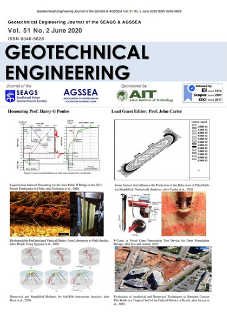Effects of Cyclic Behaviour during Pile Penetration on Pile Performance in Model Load Tests
Main Article Content
Abstract
This study focuses on the effect of ‘cyclic’ behaviour of pile installation methods on the penetration resistance and bearing capacity of a model pile. A series of laboratory model tests were conducted to investigate this cyclic effect by comparing three kinds of piling methods: monotonic jack-in, pseudo-dynamic push-in and pull-out, i.e. ‘surging’, and vibratory driving in dry or saturated sand. Surging or vibratory pile driving decrease the pile penetration resistance due to negative soil dilation caused by the cyclic shearing of the soil surrounding the pile. Static load tests show that surging and vibratory pile driving provide the same or larger pile head load as the jack-in method does. Furthermore, the fluctuation of the pore water pressure strongly indicates a change in soil dilation. Both surging and vibratory pile driving prevent positive dilation more than the jack-in method due to differences in cyclic shearing and monotonic loading.
Article Details

This work is licensed under a Creative Commons Attribution-NonCommercial-NoDerivatives 4.0 International License.
Copyright © 2019 Association of Geotechnical Societies in Southeast Asia (AGSSEA) - Southeast Asian Geotechnical Society (SEAGS).


